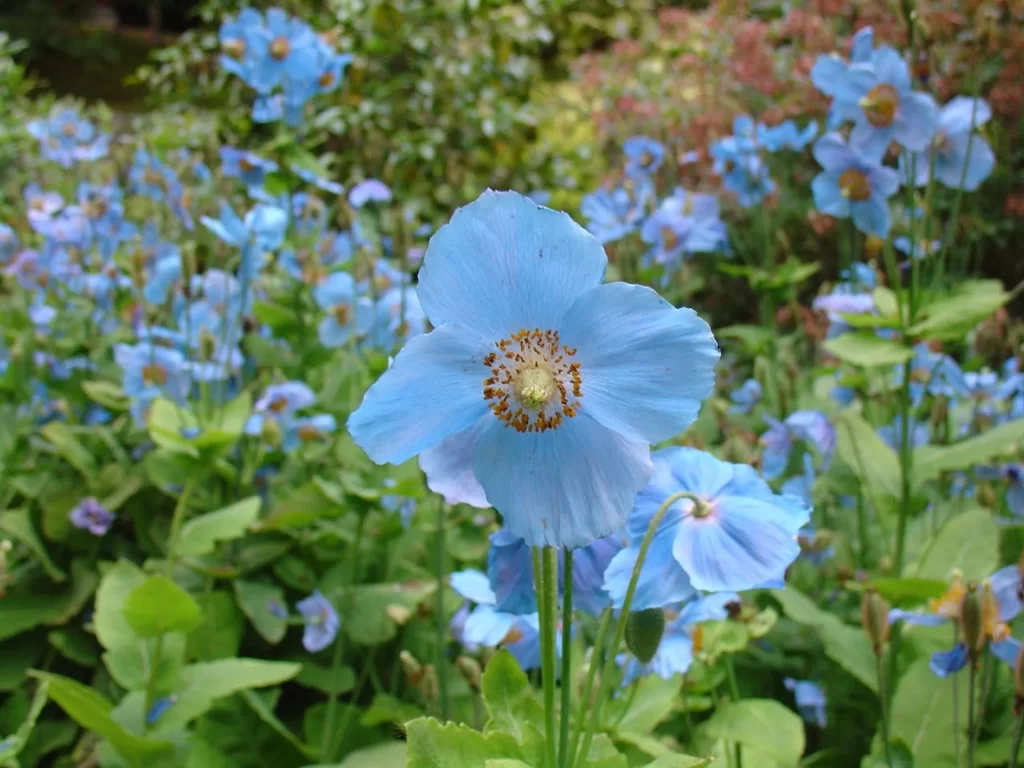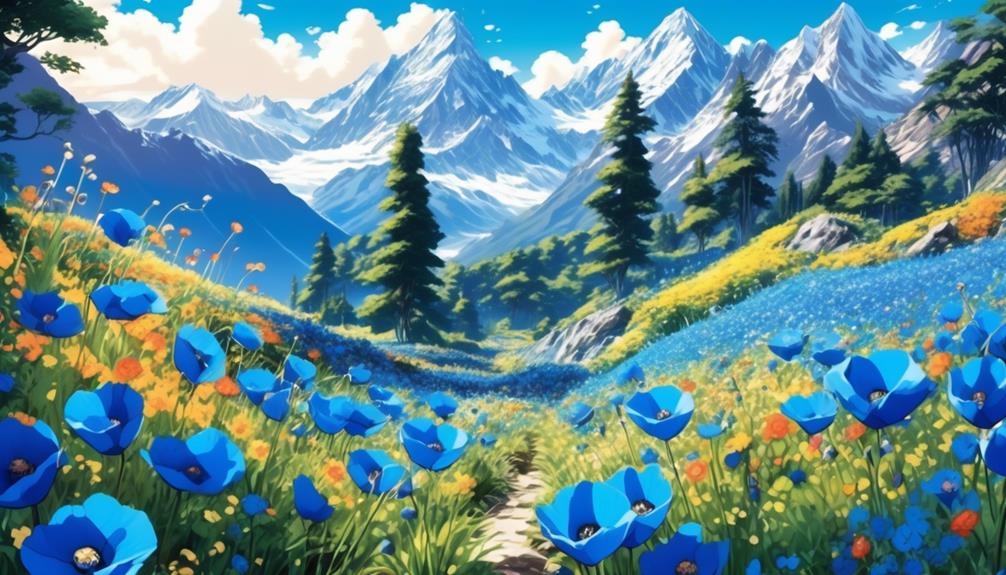Did you know that Himalayan Blue Poppies are not actually blue? Despite their name, these captivating flowers display a range of hues, including purples, lavenders, and even shades of pink. If you’ve ever dreamed of growing these elusive beauties in your garden, you’re in for a treat.
In this discussion, we will uncover the secrets to successfully cultivating Himalayan Blue Poppies, including tips on:
- Light requirements
- Ideal soil conditions
- Proper watering techniques
- Managing temperature and humidity
- Choosing the right fertilizer
- Pruning for healthy growth
- Propagating them
So, if you’re ready to unlock the mysteries of these enchanting blooms, let’s get started.

Himalayan Blue Poppy Basics
- The scientific name for the Himalayan Blue Poppy is Meconopsis betonicifolia.
- Himalayan Blue Poppies require partial shade and bright, indirect light to thrive.
- They grow best in cool summers with temperatures ranging from 55 to 60°F (13 to 15°C).
- The ideal soil for blue poppies is loamy and slightly acidic (pH 6.0 to 7.0).
- Regular watering, fertilizing, and pruning are essential for healthy growth and maintenance of shape.
Light Requirements

Himalayan Blue Poppies require partial shade with bright, indirect light for optimal growth. These delicate flowers can’t withstand intense sunlight, so it’s crucial to provide them with the right amount of shade. Dappled light, which is filtered through tree canopies, is ideal for the successful cultivation of Himalayan Blue Poppies.
In mild summer temperatures, they can tolerate more sun, preferably in the morning when the light is less harsh. However, excessive exposure to sunlight can harm these plants, especially during hot afternoon hours. Therefore, it’s essential to avoid placing them in direct sunlight. To ensure their well-being, it’s best to provide them with a location that offers partial shade throughout the day.
Himalayan Blue Poppies thrive in cool summers, making them perfect for regions with mild temperatures. They prefer temperatures ranging from approximately 55 to 60°F (13 to 15°C) for successful growth. This cool climate allows them to flourish and produce vibrant blooms.
When starting from seeds, it’s crucial to replicate their natural habitat as closely as possible. Providing them with the right amount of shade and cool temperatures will create the perfect environment for these exquisite flowers to grow and thrive.
Ideal Soil Conditions

To ensure the successful growth of Himalayan Blue Poppies, it’s crucial to provide them with ideal soil conditions. Here are four important factors to consider:
- Soil Type: Blue poppies thrive in loamy soil enriched with organic matter. This type of soil is well-drained, allowing water to pass through while retaining enough moisture for the plants to flourish. It’s best to avoid heavy clay soil, as it can lead to crown rot and hinder the growth of blue poppies.
- pH Level: The ideal pH for blue poppies is neutral to slightly acidic. Aim for a pH range of 6.0 to 7.0 to create optimal conditions for these delicate flowers. You can test the soil’s pH using a soil testing kit available at garden centers.
- Moisture: Blue poppies require consistent moisture during the growing season. However, it’s important to strike a balance and avoid waterlogging, as this can lead to root rot. Ensure the soil is moist but well-drained, never allowing it to completely dry out.
- Timing: When planting blue poppy seeds, it’s best to do so in early spring when the soil temperature is cool but not frozen. This gives the seeds a chance to establish roots before the heat of summer arrives.
‘Did You Know? Blue poppies are native to the Himalayas and are known for their stunning blue flowers. They have a rich history in Tibetan and Bhutanese cultures, where they are considered sacred and often used in religious ceremonies.’
Proper Watering Techniques

Proper watering techniques are crucial for the successful growth of Himalayan Blue Poppies (Meconopsis betonicifolia). These exquisite flowers require consistent moisture to thrive, as insufficient watering can lead to issues such as powdery mildew.
To maintain the health and vitality of your blue poppies, it is recommended to water them regularly during the summer months, preferably using soaker hoses. This ensures that the plants receive a steady supply of water and reduces the risk of overwatering or underwatering.
To help you understand the proper watering techniques for Himalayan Blue Poppies, refer to the table below:
| Watering Technique | Frequency |
|---|---|
| Regular watering with soaker hoses | During summer months |
| Monitoring water needs | Regularly |
| Application of liquid fertilizer | Every two weeks |
| Application of granular fertilizer | Once a month |
| Use of organic mulch | In the fall, after the plants are dormant |
In addition to regular watering, fertilization is also essential for the health and vigor of the plants. Liquid fertilizer can be applied every two weeks, while granular fertilizer can be used once a month. Applying organic mulch in the fall helps retain moisture and protects the roots during winter. By following these proper watering techniques, you can ensure the successful growth of your Himalayan Blue Poppies and enjoy their stunning beauty year after year.
“Did You Know? Himalayan Blue Poppies are native to the Himalayan region and are known for their vibrant blue flowers that can reach up to 3 inches in diameter. These rare and delicate flowers have a short blooming period, making them a prized addition to any garden.”
Managing Temperature and Humidity

Maintaining the appropriate temperature and humidity levels is crucial for the successful cultivation of Himalayan Blue Poppies. To ensure optimal growth and blooming of these delicate flowers, follow these guidelines:
- Temperature: Keep the environment cool, with temperatures ranging from 55 to 60°F (13 to 15°C). This temperature range mimics the cool climate of their natural habitat. Avoid exposing the plants to hot afternoon sun, especially in regions with mild summer temperatures.
- Partial Shade: Provide partial shade to protect the poppies from excessive sun exposure. This can be achieved by placing them under a tree or using shade cloth. However, make sure they still receive enough light for healthy growth.
- Humidity: Maintain moderate humidity levels to replicate the conditions found in the Himalayan mountains. While exact humidity requirements may vary, a humidity range of 40 to 60% is generally suitable for these plants.
- Fertilization: During the late spring and early summer growth period, consider using a slow-release granular fertilizer or a liquid fertilizer formulated for acid-loving plants. This will provide the necessary nutrients without overfeeding the poppies.
Choosing the Right Fertilizer

When choosing the right fertilizer for Himalayan Blue Poppies, opt for a slow-release granular or liquid fertilizer. These types of fertilizers are designed to release nutrients gradually over time, providing a consistent supply of essential elements for your plants. Liquid fertilizers can be applied every two weeks during the growing season, while granular fertilizers can be applied once a month.
Himalayan Blue Poppies are heavy feeders, meaning they require regular fertilization to promote plant vigor and health. Using a balanced organic fertilizer won’t only nourish the plants but also enrich the soil, creating an optimal environment for growth. Organic fertilizers contribute to the overall soil health and improve its structure, ensuring proper drainage and nutrient availability.
To determine the specific nutrient requirements of your Blue Poppies, it’s recommended to conduct regular soil testing. This will help identify any nutrient deficiencies and allow you to adjust your fertilizer application accordingly. By addressing any imbalances, you can ensure that your Himalayan Blue Poppies receive the necessary nutrients for successful growth.
Pruning for Healthy Growth

To promote healthy growth and maintain the shape of your Himalayan Blue Poppies, regular pruning is essential. Pruning helps remove dead or diseased parts, promoting overall plant health. Additionally, it encourages robust root development and perennial growth by removing any flower buds during the first year.
To maintain the shape and vitality of your poppies, it’s recommended to cut the plants down to the ground in late fall for maintenance. Here are some tips to ensure successful pruning:
- Remove dead or diseased parts: Regularly inspect your Himalayan Blue Poppies and prune any dead or diseased parts. This helps prevent the spread of diseases and promotes healthy foliage.
- Encourage robust root development: During the first year, it’s important to remove any flower buds. This redirects the plant’s energy towards root development, ensuring long-term growth and vitality.
- Maintain shape and vitality: Cutting the plants down to the ground in late fall helps maintain their shape and promotes new growth in the following season. This also eliminates any overgrowth that may hinder the poppies’ overall health.
- Use clean, sharp tools: When pruning, make sure to use clean and sharp tools. This minimizes damage to the plants and reduces the risk of disease transmission.
‘Did you know? Pruning not only helps maintain the health and shape of your Himalayan Blue Poppies, but it also stimulates their natural defense mechanisms, making them more resistant to pests and diseases.’
Propagating Himalayan Blue Poppies

When it comes to propagating these beautiful flowers, division is the preferred method over growing from seeds. Division is a quicker and more reliable way to propagate these delicate flowers. Autumn is the best time to divide Meconopsis plants, as it reduces stress and provides optimal conditions for rooting and growth.
To grow Himalayan Blue Poppies from seeds, sow them thinly on nutrient-rich soil or starting mix. It’s important to keep the soil evenly moist but not waterlogged. Blue poppy seeds require a decent amount of light for successful germination, so ensure they receive adequate light. The ideal germination temperatures range from 55 to 60°F (13 to 15°C).
If you prefer to grow Himalayan Blue Poppies from seeds harvested from existing plants, wait until the pods start to split and the black seeds rattle out. Harvest the seeds and store them in paper seed packets in the fridge until you’re ready to sow them. More details below.
Growing From Seed: Step-By-Step Guide
For successful cultivation of Himalayan Blue Poppies from seed, follow this step-by-step guide:
- Seed Collection and Storage: Collect ripe seed capsules when they turn brown and dry. Store them in a cool, dry place until ready for planting.
- Seed Preparation: Soak the seeds in lukewarm water for 24 hours to improve germination. Gently rub the seed coat to remove any residual gelatinous material.
- Sowing: Fill small pots or seed trays with a well-draining seed compost. Sow the seeds on the surface, spacing them about 1 inch apart. Lightly press them into the compost without covering them.
- Germination and Transplanting: Place the pots or trays in a cold frame or cool greenhouse. Maintain a temperature of around 50°F (10°C) and keep the compost moist. Germination can take several weeks. Once the seedlings have developed 2-4 leaves, transplant them into individual pots.
Remember to provide the seedlings with sufficient light and keep the soil consistently moist, but not waterlogged. Transplant the young plants into their permanent location in early fall, ensuring they’re protected from strong winds and excessive sun exposure.
Beautiful In Bloom…
Growing Himalayan Blue Poppies successfully requires careful attention to their light requirements, soil conditions, and watering techniques. It also involves managing temperature and humidity, choosing the right fertilizer, and using proper pruning methods.
Remember, these delicate flowers deserve the utmost care and protection, so go forth, fellow gardeners, and embark on this exciting and challenging journey of growing Himalayan Blue Poppies.
The beauty of their flowers are all the reward you’ll need when growing them, and when in bloom, they’ll become the talking point of your garden, that’s for sure. Happy gardening!

